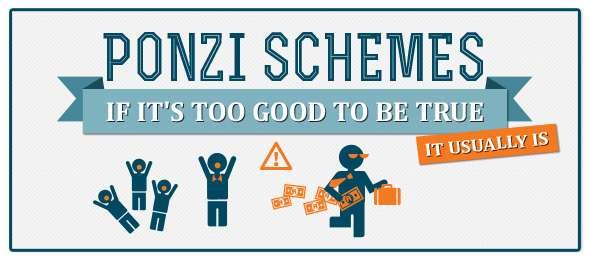Scams and Ponzi-Schemes in cryptocurrency - how to detect them

The terms pyramid scheme and Ponzi scheme can often be found in the cryptocurrency space. Many of these are opening up and the unregulated and somewhat anonymous crypto space is a paradise for scammers. There are prominent examples which have been proven almost beyond doubt to be operating as schemes which their relative investors will still defend to (verbal) death. This is part due to the effects of Cognitive Dissoance which makes the investors not want to appear stupid to themselves and others, and in part due to investors hoping that much more people will hop on and the scheme will continue, thus turning more profit for them.
What is a Ponzi scheme?
A Ponzi scheme is usually defined as an investment fraud that involves the payment of purported returns to investors from funds paid to the scheme by news investors. Ponzi schemes often persuade new participators by promising to invest funds in 'great opportunities that they claim generate high returns with almostr no risk. In most Ponzis, the scammers will put their attention toward attracting new people to make their payouts to earlier investorsso the appearance of profit will be there, again attracting new people by word of mouth.
Why do the schemes collapse?
Since the Ponzi-scheme usually is all about the facade and does not have a real way of making money as it claimes, it require a constant flow of fresh money from new investors to continue and uphold payments. Ponzis do collapse when it they can not recruit new investors fast enough anymore due to a snowball effect or when, accordingly, to many people ask to cash out at the same time.
How did the Ponzi schemes come to their name?
They are named after Charles Ponzi, who scammed thousands of people in News England in the 1920s to invest in a postage stamp speculation scheme. At this time the annual interest on a bank account was about 5%. Charles Ponzi promised investors that he could get them a 50% return on their money in just 90 days. Ponzi initially bought international mail coupons in support of his scheme to sell them at a profit, but he quickly switched to using incoming money from new folks to pay purported returns to earlier investors.
How do you spot a Ponzi?
Many Ponzi schemes do have common traits. Look for these warning signs:
- High investment returns with little risk or no mention of risk at all. Every investment in this world carries some degree of risk, this is a universal truth. Investments yielding bigger returns typically involve more risk. You should be highly suspicious of any "guaranteed" investment opportunities.
- Promised consistent returns. Investment values naturally go up and down as time flows, especially those offering high returns. Be very cautious of an investment that promises to generate regular, positive returns with no respect to market condition.
- Secret and/or complex strategies. Even though the crypto space can be complicated, you should always avoid investments you do not understand, or for which you cannot get complete information.
- Difficulty receiving payouts or converting. Be extra cautious if you do not receive a payment or have difficulty cashing out your money. Keep in mind that Ponzi schemers by their very nature encourage participants to "re-invest" investments and sometimes even promise even higher returns on re-invested amounts.
A near cousin of the Ponzi scheme is the pyramid scheme. They are closely related because they both involve paying older members with money from new participants, instead of actual generated profits:
Here are some common differences:
| _ | Pyramid Scheme | Ponzi Scheme |
|---|---|---|
| Marketing | Earn high profits by making a single payment and finding other participants to become distributors of an "investment opportunity". The scheme may or may not involve a genuine product. The purported product may not exist or it may be "sold" only for means of "tutoring" or re-distributing. | Earn high returns on your money with little or no risk by one simple one-time investment; often the business does not exist or only a small percentage of incoming funds are actually used for investment. |
| Payouts | Usually pay a one-time or recurring "participant fee" and recruit new distributors to receive payments. | No recruiting is necessary to receive payments. |
| Interaction with schemers | Sometimes no interaction at all. New investors may enter the pyramid scheme at different levels. | Promoter generally interacts directly with all participants to keep up the scheme. |
| How it works | Funds from new investors will be used to pay recruiting commissions to earlier participants. | Funds from new investors are used to pay purported returns to earlier investors. |
| Collapse | Fast. An exponential increase in the number of participants is required at each level to sustain. | May be relatively slow if existing participants reinvest money. |
Please always stay safe and cautious, do not invest in dubious schemes because in the end you will either end up being scammed or having taken the money of those that came later into the scheme.
nice informative article
Thank you for your support.
My pleasure
BITTTTCONNNNNNNECCCTTTTTT
Very, well written and concise. Just followed you! :)
Thank you, i appreciate it. :-)
Congratulations @mnemonic19! You received a personal award!
You can view your badges on your Steem Board and compare to others on the Steem Ranking
Vote for @Steemitboard as a witness to get one more award and increased upvotes!